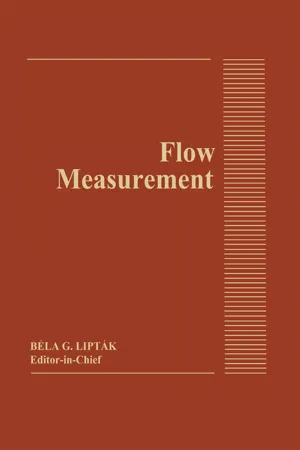
This is a test
- 222 pages
- English
- ePUB (mobile friendly)
- Available on iOS & Android
eBook - ePub
Flow Measurement
Book details
Book preview
Table of contents
Citations
About This Book
Fully illustrated with diagrams, tables, and formulas, Flow Measurement covers virtually every type of flow meter in use today.Béla G. Lipták speaks on Post-Oil Energy Technology on the AT&T Tech Channel.
Frequently asked questions
At the moment all of our mobile-responsive ePub books are available to download via the app. Most of our PDFs are also available to download and we're working on making the final remaining ones downloadable now. Learn more here.
Both plans give you full access to the library and all of Perlego’s features. The only differences are the price and subscription period: With the annual plan you’ll save around 30% compared to 12 months on the monthly plan.
We are an online textbook subscription service, where you can get access to an entire online library for less than the price of a single book per month. With over 1 million books across 1000+ topics, we’ve got you covered! Learn more here.
Look out for the read-aloud symbol on your next book to see if you can listen to it. The read-aloud tool reads text aloud for you, highlighting the text as it is being read. You can pause it, speed it up and slow it down. Learn more here.
Yes, you can access Flow Measurement by Bela G. Liptak in PDF and/or ePUB format, as well as other popular books in Technology & Engineering & Engineering General. We have over one million books available in our catalogue for you to explore.
Information
1 Application and Selection
D. J. LOMAS (1982) B. G. LIPTÁK (1993)
METER SELECTION
The variety of choices facing an engineer confronted with a flow measurement application is vast. Table A lists many different categories of flowmeters. In nearly every case each category further subdivides into several distinctly different variants. For example, the positive displacement principle types include rotary piston, oval gear, sliding vane, and reciprocating piston. If these subvariants are included, the engineer faces a confusing list of well over 50 different meter types. Each type has advantages and limitations and no one type combines all the features and all the advantages.
A brief summary of the relevant advantages and limitation of each basic category is given below. Comparison tables on some of the key parameters, such as accuracy, flow range, and operating temperature, are also provided. It is hoped that this information, together with the basic selection philosophy outlined, will assist in finding a way through the maze of meter types and in selecting suitable meters for specific applications.
Having narrowed the list of choices, the engineer can then consult the other sections for detailed information on the meters concerned.
DIFFERENTIAL PRESSURE
This is undoubtedly the most widely used method of industrial flow measurement. A restriction is introduced into the pipe. The resulting pressure decrease is proportional to flow rate in accordance with the formula:
1(1) |
Differential pressure meters have the advantage that they are the most familiar of any meter type. They are suitable for gas and liquid, viscous and corrosive fluids. There are no significant pipe size or flow rate limitations and they have no moving components. All differential pressure meters exhibit a square law relationship between head and flow rate which severely limits the usable flow range (typically 4:1 maximum). Another disadvantage is that in addition to the sensor element, a separate transmitter is required. Furthermore, a manifold and shutoff valves are required to attach the transmitter to the sensor (causing potential leakage points), and the fluid density must be known or measured.
Energy Costs
The yearly energy cost of operating differential-pressure-type flowmeters can in some cases exceed the purchase price of the meter. The permanent pressure loss through a flowmeter is usually expressed in units of velocity heads. The velocity head is calculated as V2/2g, where V is the flowing velocity and g is the gravitational acceleration (9.819 m/s2 or 32.215 ft/s2 at 60 degrees latitude).
Therefore, the velocity head at, say, 10 ft/s flowing velocity is calculated in the English units as ft of the flowing fluid. If the flowing velocity is 3 m/s, the velocity head is calculated in the metric units as meters of the flowing fluid. The velocity head is converted into pressure drop by multiplying it with the specific gravity of the flowing fluid. Different flowmeters require different pressure drops for their operation:
Flowmeter Type | Permanent Pressure Loss (in Velocity Heads) |
|---|---|
Orifice plates | Over 4 |
Vortex shed... |
Table of contents
- Cover
- Half Title
- Title Page
- Dedication
- Copyright Page
- Table of Contents
- Contributors
- Introduction
- Orientation Tables
- 1 Application and Selection
- 2 BTU Flowmeters for Heat Exchangers
- 3 BTU Flowmeters for Gaseous Fuels
- 4 Cross-Correlation Flowmetering
- 5 Elbow Taps
- 6 Flow Switches
- 7 Jet Deflection flow Detectors
- 8 Laminar Flowmeters
- 9 Magnetic Flowmeters
- 10 Mass Flowmeters—Coriolis
- 11 Mass Flowmeters—Miscellaneous
- 12 Mass Flowmeters—Thermal
- 13 Metering Pumps
- 14 Orifices
- 15 Pitot Tubes, Averaging and Duct Section Units
- 16 Positive Displacement Gas Flowmeters
- 17 Positive Displacement Liquid Meters and Provers
- 18 Purge Flow Regulators
- 19 Segmental Wedge Flowmeter
- 20 Sight Flow Indicators
- 21 Solids Flowmeters and Feeders
- 22 Target Meters
- 23 Turbine and Other Rotary Element Flowmeters
- 24 Ultrasonic Flowmeters
- 25 Variable-Area, Gap, and Vane Flowmeters
- 26 V-Cone Flowmeter
- 27 Venturi Tubes, Flow Tubes, and Flow Nozzles
- 28 Vortex and Fluidic Flowmeters
- 29 Weirs and Flumes
- A.1 International System of Units
- A.2 Engineering Conversion Factors
- Index